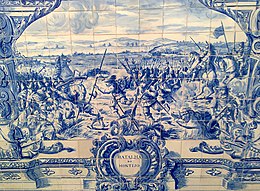Bataille de Montijo
| Date | |
|---|---|
| Lieu | Montijo |
| Issue |
Indécise: Les deux camps revendiquent la victoire[1],[2],[3],[4],[5],[6],[7],[8],[9],[10],[11]. [12],[13],[14],[15],[16],[17],[18] |
| Marquis de Torrecuso | Matias de Albuquerque, Comte d'Alegrete |
| 4 000 fantassins 1 700 cavaliers 2 canons[17] |
6 000 fantassins 1 100 cavaliers 6 canons[19] |
| 813 - 3 000 morts ou blessés[20],[21] | 900 - 3 000 morts, blessés ou prisonniers[17],[22] |
Guerre de Restauration du Portugal
Batailles
La bataille de Montijo[23] opposa les Espagnols commandés par Ghislain de Bryas, baron de Molinghem aux Portugais de Mathias de Albuquerque, en 1644.
C'est l'une des premières grandes batailles de la guerre de Restauration du Portugal, dont les débuts constituent l'un des épisodes de la période finale de la guerre de Trente Ans.
Elle est considérée par certains comme une victoire portugaise, mais d'autres historiens sont d'un avis différent, soulignant que ce sont les Portugais qui ont quitté le champ de bataille.
Déroulement modifier
Après avoir quitté Campo Maior, l'armée portugaise commandée par Matias d'Albuquerque, forte de 1 100 cavaliers, 6 000 fantassins et 6 pièces d'artillerie, s'avança en Estremadure, dans le but de livrer bataille. L'armée espagnole du Marquis de Torrecuso, composée de 1 700 cavaliers, 4 000 fantassins et 2 pièces d'artillerie, vint à sa rencontre. Les deux armées s'affrontèrent a Montijo, le 26 mai 1644.
Les Portugais disposèrent leurs forces sur une position élevée, les Espagnols en contrebas, les deux camps optant pour une disposition classique, infanterie au centre formée en tercios, artillerie en avant, et la cavalerie sur les ailes. Les Portugais renforcèrent la leur par 400 mousquetaires afin de compenser leur infériorité numérique.
La bataille commença vers 9 h du matin, par une violente charge des ailes de cavalerie espagnole, qui dispersèrent la cavalerie portugaise, puis ce fut l'assaut des tercios espagnols, qui firent d'abord reculer l'infanterie portugaise, parvenant même à rompre ses lignes ; toutefois celle-ci parvint à se regrouper puis à contre-attaquer. D'après certains historiens, lors d'un farouche corps à corps, les tercios espagnols, probablement mal soutenus par leur cavalerie, perdirent pied et l'armée espagnole se retira en désordre. Le combat prit fin vers 15h, laissant les Portugais maîtres du terrain. D'autres historiens affirment un retrait portugais, ce qui indique une issue indécise.
Les pertes portugaises sont de 900 à 3 000 hommes (tués, blessés et prisonniers), soit environ tout autant que celles des Espagnols.
Notes et références modifier
- Eggenberger, Finally, in 1644, a Portuguese army under Gen. Mathias d'Albuquerque invaded western Spain. On May 26 Albuquerque's troops met and defeated a Spanish army of Philip IV at Montijo p.285
- Nolan, Montijo, Battle of (1644). Four years after regaining independence from Spain, Portugal invaded western Spain in retaliation for continuing Spanish plots against the Portuguese monarchy. With Spain still bogged down in the eighty Years' War with the Netherlands and another long war with France, the Portuguese won an easy victory that secured them from further interference for a dozen years, tough it did not bring formal peace. p.607
- H. V. Livermore, in 1644 the Portuguese won the victory of Montijo and thereafter held the Castilians on the defensive. p.303
- The Encyclopædia Britannica, The first battle was fought at Montijo in 1644, between a Portuguese army of 6000 foot and 1100 horse, and a Spanish army of nearly the same number. The latter were entirely defeated, and this contributed greatly to establish the affairs of Portugal on a firm basis. p.386
- Wright, ...The founder of the Braganza dynasty, he expelled a Spanish usurper and proclaimed himself King in 1640. He defeated the Spanish at Montijo in 1644. p. 335
- Clodfelter, p.43
- Edward McMurdo, Many skirmishes took place in Beira and Tras-os-Montes but bore no results as far as concerned the greater consolidation of the restoration. The greatest and most signal victory gained by the Portuguese was the battle of Montijo on the 26th of May, 1644. p.391
- History of Portugal, The victory, due to the enterprise of Matias de Albuquerque caused great rejoicing in Lisbon p.292
- Jaques, At Montijo, west of Badajoz, Albuquerque routed a Spanish army. War continued intermittently for another 20 years before Philip finallyrecognized Portuguese independence. p.340
- Sandler, Portugal won battles at Olivenca and Beira in 1642, then invaded Spain in May 1644 under General Mathias d'Albuquerque, and won a major victory at the Battle of Montijo. p.835
- Vincent, John IV duke of Braganza, made King during an insurrection against the Spaniards ruled vigorously; defeated the Spaniards at Montijo, 26 May 1644.p.301
- Contreras y López de Ayala Lozoya p.444
- Artola p.593
- Ibarra y Rodríguez p.399
- The Journal of military history p.399
- Ventura i Subirats p.127
- Real academia de la historia p.428
- Modesto Lafuente p.354
- Ângelo Ribeiro p.59
- Clodfelter, ...attempts to reconquer Portugal culminated in a counterattack by Portuguese General Mathias d'Albuquerque into Spain with French and English aid and his defeat of the Spanish at Montijo near Badajoz on May 26, 1644. Of 8.000 infantry and 2.500 cavalry engaged the Spanish lost 3,000 killed and wounded. p.43
- Valladares de Sotomayor p.188
- Ângelo Ribeiro, p.60
- La bataille a eu lieu près de la ville espagnole de Montijo, à ne pas confondre avec la ville portugaise du même nom.
Voir aussi modifier
Liens externes modifier
- (fr) Bataille de Montijo
